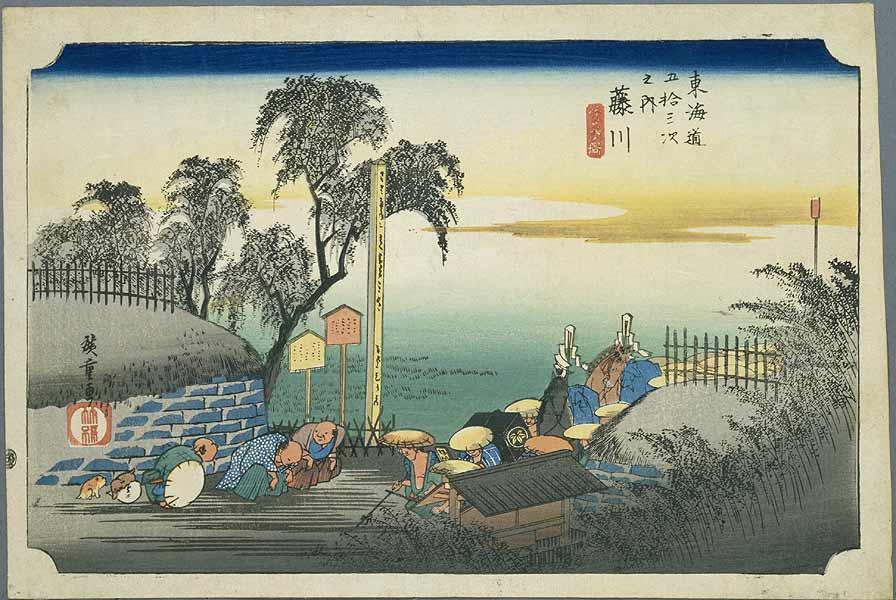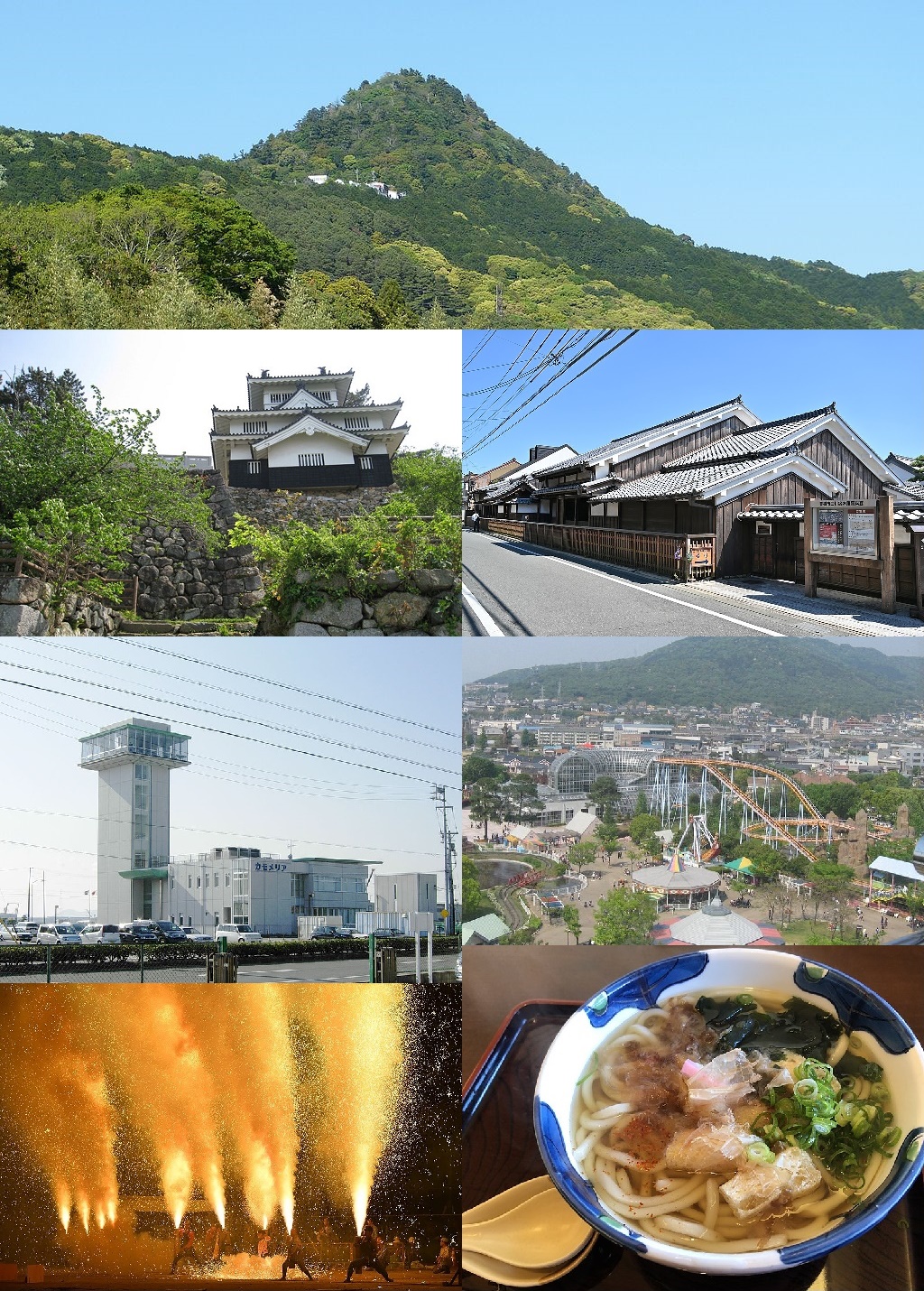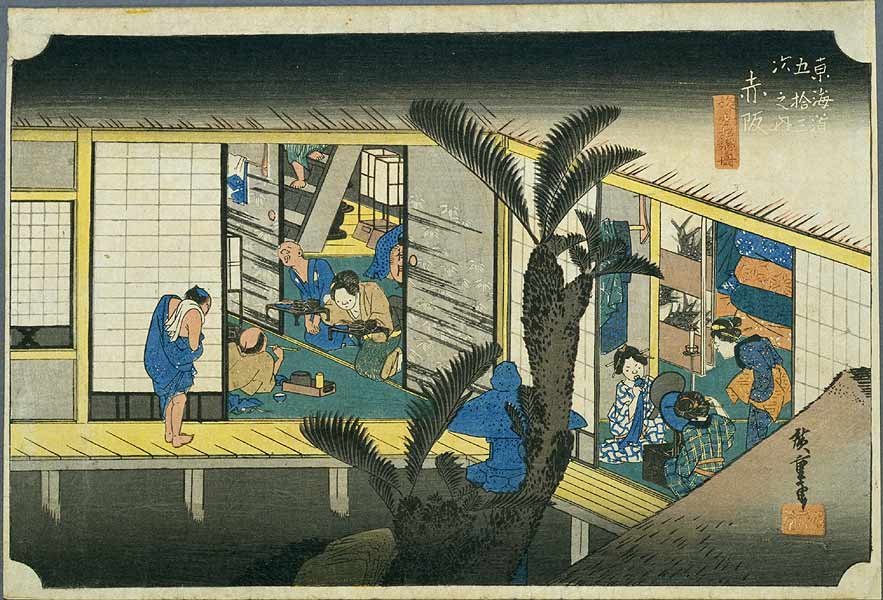|
Okazaki-shuku
was the thirty-eighth of the fifty-three stations of the Tōkaidō. It is located in the present-day city of Okazaki, in Aichi Prefecture, Japan. History Okazaki-shuku was a part of the flourishing castle town surrounding Okazaki Castle, the headquarters for Okazaki Domain. The classic ukiyo-e print by Andō Hiroshige (Hōeidō edition) from 1831 to 1834 depicts a ''Yahagibashi'', one of the few bridges permitted by the Tokugawa shogunate on the Tōkaidō, and one of the longest bridges built in Japan during the early Edo period. Okazaki Castle is depicted in the distance on the far shore of the river. Following the Meiji restoration, with the construction of railroads, the route of what became the Tokaido Main Line was laid down through the nearby village of Hane ( ''Hane-mura'') to the south. Unlike Goyu-shuku and Akasaka-juku, but this did not cause a huge economic decline to Okazaki-shuku. There was a horse-drawn rail line connecting Okazaki to the train station, as ... [...More Info...] [...Related Items...] OR: [Wikipedia] [Google] [Baidu] |
53 Stations Of The Tōkaidō
The are the rest areas along the Tōkaidō, which was a coastal route that ran from Nihonbashi in Edo (modern-day Tokyo) to Sanjō Ōhashi in Kyoto.. There were originally 53 government post stations along the Tōkaidō, where travelers had to present traveling permits at each station if wanting to cross. In 1619, the Ōsaka Kaidō (大阪街道) was developed to extend the Tōkaidō so that it would reach Kōraibashi in modern-day Osaka. Instead of going to Sanjō Ōhashi, travelers would leave from Ōtsu-juku and travel towards Fushimi-juku. Because of the addition of these four post towns, the Tōkaidō is occasionally referred to as having 57 stations. Another name for this extension was Kyōkaidō (京街道). The inland Nakasendō also started at Nihonbashi, and converged with the Tōkaidō at Kusatsu-juku. Shio no Michi intersected with the Tōkaidō at Okazaki-shuku. Stations of the Tōkaidō See also * Edo Five Routes ** 69 Stations of the Nakase ... [...More Info...] [...Related Items...] OR: [Wikipedia] [Google] [Baidu] |
Shio No Michi
was an old ''kaidō'', or road, in ancient Japan and was used to transport salt from the ocean to the inland central Honshū. In the Middle Ages, salt was brought both from the Sea of Japan and the Pacific Ocean to Shinano Province for processing. The road leading from the Sea of Japan to Shinano Province was called the ''Chikuni Kaidō'' (千国街道), whereas the road leading from the Pacific Ocean was called the ''Sanshū Kaidō'' (三州街道).Shio no Michi wo Tabi Suru . Salt Road Museum. Accessed December 20, 2007. Stations of the Chikuni Kaidō On the side of the route, it was called the ''Itoigawa Kaidō'', but on the Shinano Province side, it was called ''Chikuni ...[...More Info...] [...Related Items...] OR: [Wikipedia] [Google] [Baidu] |
Chiryū-juku
was the thirty-ninth of the fifty-three stations of the Tōkaidō. It is located in the present-day city of Chiryū in Aichi Prefecture, Japan. It was the westernmost post town in Mikawa Province, and was from Nihonbashi, the start of the Tōkaidō, so it took approximately 10 days to for average travellers to reach. History Chiryū-juku was noted for a famed Shinto shrine, the Chiryū Daimyōjin, and also for its flourishing horse market, held in late April to early May of each year. Tokugawa Ieyasu ordered that the post station plant pine trees along through route of the highway before and after the town. The classic ukiyo-e print by Andō Hiroshige (Hōeidō edition) from 1831 to 1834 depicts horses, and also one of the pine trees. Hiroshige entitled the work . Despite the construction of railroads following the Meiji restoration the horse market continued into the Shōwa period, and most of the pine trees survived until the 1959 Isewan Typhoon. Neighboring post tow ... [...More Info...] [...Related Items...] OR: [Wikipedia] [Google] [Baidu] |
Fujikawa-shuku
was the thirty-seventh of the fifty-three stations of the Tōkaidō. It is located in the present-day city of Okazaki, in Aichi Prefecture, Japan. It was approximately from Akasaka-juku, the preceding post station.Tokaido 53: Fujikawa-juku (Okazaki) . Tōkaidō no Tabi. Accessed March 6, 2008. Another accepted reading for this post town is "Fujikawa-juku." At its peak, Fujikawa-juku was home to 302 buildings, including one '' honjin'', one sub-''honjin'' and 36 '' hatago''. Its total population was approximately 1,200 people. The classic |
Shukuba
were post stations during the Edo period in Japan, generally located on one of the Edo Five Routes or one of its sub-routes. They were also called ''shuku-eki'' (宿駅). These post stations (or "post towns") were places where travelers could rest on their journey around the nation. They were created based on policies for the transportation of goods by horseback that were developed during the Nara and Heian periods. History These post stations were first established by Tokugawa Ieyasu shortly after the end of the Battle of Sekigahara. The first post stations were developed along the Tōkaidō (followed by stations on the Nakasendō and other routes). In 1601, the first of the Tōkaidō's fifty-three stations were developed, stretching from Shinagawa-juku in Edo to Ōtsu-juku in Ōmi Province. Not all the post stations were built at the same time, however, as the last one was built in 1624. The lodgings in the post stations were established for use by public officials and, ... [...More Info...] [...Related Items...] OR: [Wikipedia] [Google] [Baidu] |
World War II
World War II or the Second World War, often abbreviated as WWII or WW2, was a world war that lasted from 1939 to 1945. It involved the vast majority of the world's countries—including all of the great powers—forming two opposing military alliances: the Allies and the Axis powers. World War II was a total war that directly involved more than 100 million personnel from more than 30 countries. The major participants in the war threw their entire economic, industrial, and scientific capabilities behind the war effort, blurring the distinction between civilian and military resources. Aircraft played a major role in the conflict, enabling the strategic bombing of population centres and deploying the only two nuclear weapons ever used in war. World War II was by far the deadliest conflict in human history; it resulted in 70 to 85 million fatalities, mostly among civilians. Tens of millions died due to genocides (including the Holocaust), starvation, ma ... [...More Info...] [...Related Items...] OR: [Wikipedia] [Google] [Baidu] |
Toyohashi, Aichi
is a city in Aichi Prefecture, Japan. , the city had an estimated population of 377,453 in 160,516 households and a population density of 1,400 persons per km2. The total area of the city was . By area, Toyohashi was Aichi Prefecture's second-largest city until March 31, 2005 when it was surpassed by the city of Toyota, which had merged with six peripheral municipalities. Geography Toyohashi is located in southeastern Aichi Prefecture, and is the capital of the informal "Higashi-Mikawa Region" of the prefecture. It is bordered by Shizuoka Prefecture to the east, and by Mikawa Bay and the headlands of the Atsumi Peninsula to the west. To the south is the Enshu Bay of the Pacific Ocean. The presence of the warm Kuroshio Current offshore gives the city a temperate climate. The in Toyohashi is a sea turtle nesting spot. Climate The city has a climate characterized by hot and humid summers, and relatively mild winters (Köppen climate classification ''Cfa''). The average annual tempe ... [...More Info...] [...Related Items...] OR: [Wikipedia] [Google] [Baidu] |
Akasaka-juku (Tōkaidō)
was the thirty-sixth of the fifty-three stations of the Tōkaidō. It is located in present-day Toyokawa, Aichi Prefecture, Japan. It was only from Goyu-juku, the preceding post station. History Along with the preceding Yoshida-juku and Goyu-shuku, Akasaka-juku was well known for its '' meshimori onna''. The classic ukiyo-e print by Andō Hiroshige (''Hoeido'' edition) from 1831–1834 depicts a typical inn; the scene is divided in half by a sago palm in the center. To the right, travellers are taking their evening meal, and to the left, prostitutes are putting on make-up and preparing for the evening entertainment. Due to its reputation, Akasaka was a popular post station with many travellers. Ōhashi-ya (大橋屋), an inn that first opened in 1649, less than half a century after the creation of the Tōkaidō, still operates today. The building it uses was built in 1716. During a census in 1733, there were 83 inns in Akasaka-juku, but only Ōhashi-ya remains today. ... [...More Info...] [...Related Items...] OR: [Wikipedia] [Google] [Baidu] |
Goyu-shuku
was the thirty-fifth of the fifty-three stations of the Tōkaidō. It is located in Goyu-chō in the city of Toyokawa, Aichi Prefecture, Japan. A pine tree colonnade, one of the few remnants from the Edo period post town, is a well-known tourist spot. It was approximately from Yoshida-juku, the preceding post station. History Goyu-shuku was established in 1601, at the behest of Tokugawa Ieyasu. At its most prosperous, there were four ''honjin'' in the post town, though there were never less than two at any point. The classic ukiyo-e print by Andō Hiroshige (Hōeidō edition) from 1831–1834 depicts the main street of the post town at dusk, with aggressive female touts (for which the post station was infamous) attempting to drag travellers into teahouses and inns for the night. During the Meiji Restoration, the central office for the Hoi District, making it the center of the district. However, when the Tōkaidō Main Line was laid down and bypassed Goyu-shuku, it did not ... [...More Info...] [...Related Items...] OR: [Wikipedia] [Google] [Baidu] |
Meiji Restoration
The , referred to at the time as the , and also known as the Meiji Renovation, Revolution, Regeneration, Reform, or Renewal, was a political event that restored practical imperial rule to Japan in 1868 under Emperor Meiji. Although there were ruling emperors before the Meiji Restoration, the events restored practical abilities and consolidated the political system under the Emperor of Japan. The goals of the restored government were expressed by the new emperor in the Charter Oath. The Restoration led to enormous changes in Japan's political and social structure and spanned both the late Edo period (often called the Bakumatsu) and the beginning of the Meiji era, during which time Japan rapidly Industrialisation, industrialized and adopted Western culture, Western ideas and production methods. Foreign influence The Japanese knew they were behind the Western powers when US Commodore (United States), Commodore Matthew C. Perry came to Japan in 1853 in Black Ships, large warshi ... [...More Info...] [...Related Items...] OR: [Wikipedia] [Google] [Baidu] |








